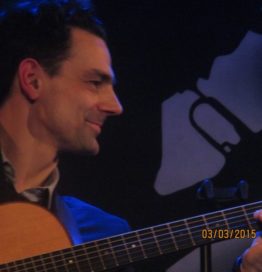
There are many ways that so-called “Gypsy jazz” can be distinguished from North America’s homegrown jazz traditions. One of them—and one often neglected by even those North Americans who get deeply into the style—is the extent to which la musette and swing waltzes are included in the repertoire. Django Reinhardt’s own professional career as a musician, after all, started as an accompanist in the rowdy dance halls where the bal musette provided entertainment for working class Parisians. Though he himself never recorded any of this repertoire he surely played it. In fact he is credited with composing several pieces that are now central to the canon—”Montagne Sainte-Geneviève” being the best known of them. Here’s another: “Gagoug.”
That performance is by a newcomer to Django in June, Christophe Astolfi. An Italian national, born in Luxembourg, long residing in France—welcome to the blurred borders of his life. With a proper slingshot, he probably could have landed a stone in either Luxembourg or Belgium from the French village where he was raised: Hussigny-Godbrange, in the region of Longwy. Mining country that experienced a wave of immigration of Italians in 1960’s, Longwy became home away from home for many accordionists and guitarists who carried on and comingled traditions of the bal musette. When Christophe first began learning guitar his teenage mind burned with Jimi Hendrix’s “Fire“. Instead, he got “Flambée Montalbanaise“.
It happened like this. At age 17 Christophe decided to drop out of school. His best friend was in the same situation, and that friend’s father was a working accordionist. The elder took the two of them under his bellows, so to speak, and trained them to be his accompanists. “Every Saturday we would go learn different dances in the repertoire—les pasodobles, les cha-cha-cha, les rumba, les valses.” Their mentor’s instruction were simple and exact: “He wanted me to do what he called la locomotive of Django.” In the coming years Astolfi provided that locomotive—and lead guitar services, as required—for and with some of the best in Gypsy jazz including Tchavolo, Dorado et Samson Schmidt. More recently he has been working closely with the Ferré brothers, Boulou and Elios as the troisième of Les Bande des Trois.
Still, porous as Christophe’s borders may be, there remains one region of the musical landscape where he staked his first and firmest claim—that of la musette and the swing valse. In 2013 he recorded Christophe Astolfi et son trio jouent… des valses. (“Christophe Astolfi and his trio play…waltzes.”) The review at Django Station of that collection includes high praise, though to fully appreciate it you need to be familiar with three classic recordings by, respectively, Baro Ferret, Matelo Ferret and Romane: “Here you have an album that can join the very exclusive club of Swing Valses d’hier et d’aujourd’hui, Tziganskaïa, and Impair et valse.”
This video was taken at the CD release party for that work—the lighting on Christophe isn’t great, but his playing is!